Black & Decker BDCD220RSR, DR260BR, NST1118, NST1118R, NST2118 User Manual
...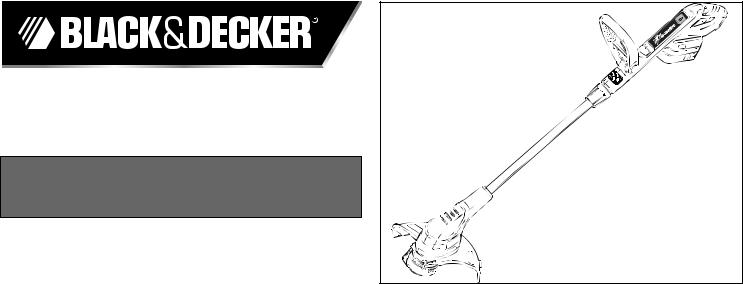
INSTRUCTION MANUAL |
|
Model Numbers NST1118, NST2118 |
|
to www.BlackandDecker.com/NewOwner |
|
to register your new product. |
|
PLEASE READ BEFORE RETURNING |
|
THIS PRODUCT FOR ANY REASON: |
|
If you have a question or experience a problem with your |
|
Black & Decker purchase, go to |
|
WWW.BLACKANDDECKER.COM/INSTANTANSWERS |
|
for instant answers 24 hours a day. |
|
If you canʼt find the answer or do not have access to the internet, |
|
call 1-800-544-6986 from 8 a.m. to 5 p.m. EST Mon. - Fri |
|
to speak with an agent. |
|
Please have the catalog number available when you call. |
|
SAVE THIS MANUAL FOR FUTURE REFERENCE. |
|
VEA EL ESPAÑOL EN LA CONTRAPORTADA. |
|
POUR LE FRANÇAIS, VOIR LA COUVERTURE ARRIÈRE. |
|
INSTRUCTIVO DE OPERACIÓN, CENTROS DE SERVICIOY |
|
PÓLIZA DE GARANTÍA. ADVERTENCIA: LÉASE ESTE |
|
INSTRUCTIVO ANTES DE USAR EL PRODUCTO. |
1 |
|
Model #
NST1118, NST2118
KEY INFORMATION YOU SHOULD KNOW:
• The guard must be installed before trimming or edging - if not, the motor will overheat (page 7).
• When replacing the line, use only .065 inch diameter ROUND line (B&D Model #AF-100 is recommended) - otherwise the tool will not function properly (page 9).
• Do not bump the feed head against the ground - it will disrupt the feed mechanism.
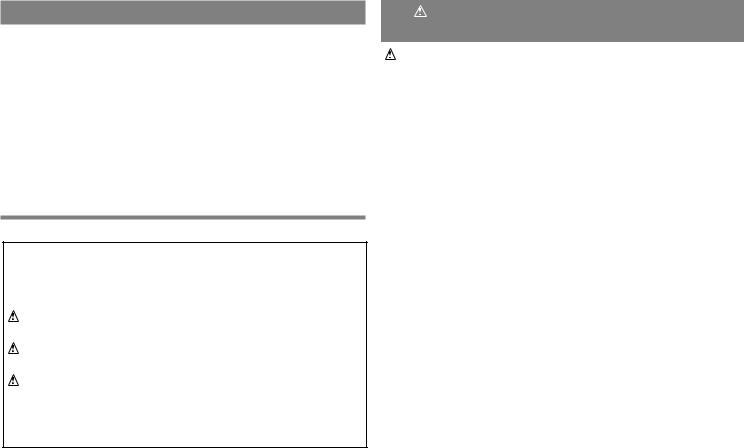
TABLE OF CONTENTS |
|
Safety Guidelines - Definitions................................................. |
2 |
Important Safety Warnings and Instructions ............................ |
2 |
Components............................................................................. |
4 |
Important Safety Instructions for Battery Chargers.................. |
4 |
Charging Procedure................................................................. |
5 |
Assembly / Adjustment ............................................................ |
7 |
Operating Instructions.............................................................. |
8 |
Replacement Accessories ....................................................... |
9 |
Maintenance ............................................................................ |
11 |
Troubleshooting ....................................................................... |
12 |
Service Information .................................................................. |
12 |
Full Two-Year Home Use Warranty.......................................... |
12 |
SAFETY GUIDELINES - DEFINITIONS
It is important for you to read and understand this manual. The information it contains relates to protecting YOUR SAFETY and PREVENTING PROBLEMS. The symbols below are used to help you recognize this information.
DANGER: Indicates an imminently hazardous situation which, if not avoided, will result in death or serious injury.
WARNING: Indicates a potentially hazardous situation which, if not avoided, could result in death or serious injury.
CAUTION: Indicates a potentially hazardous situation which, if not avoided, may result in minor or moderate injury.
NOTICE: Used without the safety alert symbol indicates a potentially hazardous situation which, if not avoided, may result in property damage.
AND INSTRUCTIONS
WARNING: When using electric gardening appliances, basic safety precautions should always be followed to reduce risk of fire, electric shock, and personal injury, including the following.
Read All Instructions
• ALWAYS WEAR EYE PROTECTION – Wear safety spectacles or goggles at all times when this tool is plugged in.
• GUARD – Do not use this tool without guard attached.
• DRESS PROPERLY – Do not wear loose clothing or jewelry. They can be caught in moving parts. Rubber gloves and substantial rubber soled footwear are recommended when working outdoors. Donʼt operate the tool when barefoot or wearing open sandals. Wear long pants to protect your legs. Wear protective hair covering to contain long hair.
• NYLON LINE – Keep face, hands and feet clear of rotating nylon line at all times.
• THE ROTATING LINE PERFORMS A CUTTING FUNCTION –
Use care when trimming around screens and desirable plantings.
• KEEP ALL BYSTANDERS AWAY– at a safe distance from work area, especially children.
• IMPORTANT WARNING – When being used as an Edger, stones, pieces of metal and other objects can be thrown out at high speed by the line. The tool and guard are designed to reduce the danger. However, the following special precautions should be taken:
• MAKE SURE that other persons and pets are at least 100 feet (30m) away.
• TO REDUCE THE RISK of rebound (ricochet) injury, work going away from any nearby solid object such as wall, steps, large stone, tree, etc. Use great care when working close to solid objects and where necessary, do edging or trimming by hand.
2
• AVOID ACCIDENTALLYSTARTING – Donʼt carry plugged-in tool with finger on trigger.

• DO NOT FORCE THE TOOL – at a rate faster than the rate at |
|
• Keep guards in place and in working order. |
|||
which it is able to cut effectively. |
|
• Keep hands and feet away from cutting area. |
|||
• USE THE RIGHT TOOL – Do not use this tool for any job except |
|
SAVE THESE INSTRUCTIONS |
|||
that for which it is intended. |
|
||||
• DONʼTOVERREACH – Keep properfootingandbalanceat all times. |
|
The label on your tool may include the following symbols. The |
|||
• DAMAGE TO UNIT – If you strike or become entangled with a |
|
||||
foreign object, stop tool immediately, unplug, check for damage |
|
symbols and their definitions are as follows: |
|||
and have any damage repaired before further operation is |
|
V ..............volts |
A ................amperes |
||
attempted. Do not operate with a broken hub or spool. |
|
Hz ............hertz |
W................watts |
||
• DISCONNECT TOOL – when not in use, when replacing line, or |
|
min............minutes |
|
|
..............alternating current |
prior to cleaning. |
|
..........direct current |
no ..............no load speed |
||
• AVOID DANGEROUS ENVIRONMENTAL CONDITIONS – Do |
|
..............Class II Construction |
|
|
............earthing terminal |
not use electric tools in damp or wet locations. Follow all |
|
|
|
||
|
|
|
|||
|
|
|
|||
instructions in this Instruction Manual for proper operation of your |
|
............safety alert symbol |
|
.../min ......revolutions or |
|
tool. Donʼt use the tool in the rain. |
|
|
|||
• DO NOT OPERATE portable electric tools in gaseous or |
|
|
|
|
reciprocations per minute |
the sparks might ignite fumes. |
|
WARNING: Some dust created by this product contains |
|||
explosive atmospheres. Motors in these tools normally spark, and |
|
chemicals known to the State of California to cause cancer, |
|||
• STORE IDLE TOOLS INDOORS – When not in use, tools |
|
||||
|
birth defects or other reproductive harm. Some examples of |
||||
should be stored indoors in a dry,locked-up place out of reach of |
|
||||
|
these chemicals are: |
|
|
|
|
children. |
|
|
|
|
|
|
• compounds in fertilizers |
|
|
|
|
• STAY ALERT – Watch what you are doing. Use common sense. |
|
|
|
|
|
Do not operate tool when you are tired. |
|
• compounds in insecticides, herbicides and pesticides |
|||
• MAINTAIN APPLIANCES WITH CARE – Follow instructions in |
|
• arsenic and chromium from chemically treated lumber |
|||
maintenance section. Keep handles dry, clean and free from oil |
|
To reduce your exposure to these chemicals, wear approved safety |
|||
and grease. |
|
equipment such as dust masks that are specially designed to filter out |
|||
• CHECK DAMAGED PARTS – Before further use of the |
|
microscopic particles. |
|
|
|
appliance, a guard or other part that is damaged should be |
|
BATTERY CAP INFORMATION |
|
|
|
carefully checked to determine that it will operate properly and |
|
Battery storage and carrying caps are provided for use whenever |
|||
perform its intended function. Check for alignment of moving |
|
the battery is out of the unit or charger. Remove cap before placing |
|||
parts, binding of moving parts, breakage of parts, mounting, and |
|
battery in charger or unit. |
|
|
|
any other condition that may affect its operation. A guard or other |
|
WARNING: Fire hazard. Do not store or carry battery so that |
|||
part that is damaged should be properly repaired or replaced by |
|
||||
an authorized service center unless otherwise indicated |
|
metal objects can contact exposed battery terminals. For example, |
|||
elsewhere in this manual. |
|
do not place battery in aprons, pockets, tool boxes, product kit |
|||
• DO NOT immerse tool in water or squirt it with a hose. DO NOT |
|
boxes, drawers, etc., with loose nails, screws, keys, etc. |
|||
allow any liquid to get inside it. |
|
Transporting batteries can possibly cause fires if the battery |
|||
• DO NOT store the tool on or adjacent to fertilizers or chemicals. |
|
terminals inadvertently come in contact with conductive materials |
|||
• DO NOT clean with a pressure washer. |
|
such as keys, coins, hand tools and the like. The US Department of |
|||
|
3 |
Transportation Hazardous Material Regulations (HMR) actually |
|||

prohibit transporting batteries in commerce or on airplanes (i.e., |
|||||||||||
packed in suitcases and carry-on luggage) UNLESS they are |
|||||||||||
properly protected from short circuits. So when transporting |
|||||||||||
individual batteries, make sure that the battery terminals are |
|||||||||||
protected and well insulated from materials that could contact them |
|||||||||||
and cause a short circuit. |
|
|
|
|
|
|
|
||||
|
COMPONENTS |
|
|
1 |
|||||||
|
|
|
|
|
|||||||
|
|
|
|
|
|
|
|
|
|
|
|
|
|
|
|
|
|
|
|
|
|
|
|
1. |
Switch |
|
|
|
|
|
|
|
|
||
2. |
Battery |
|
2 |
||||||||
|
|
|
|
|
|||||||
3. |
Auxillary Handle |
|
3 |
|
|||||||
4. |
Collar (to adjust height |
|
|
|
|
|
|
|
|
||
|
and edge) |
|
4 |
|
|||||||
|
|
|
|
|
|
||||||
5. |
Motor Housing |
|
|
|
|
|
|
|
|
||
6. |
Edge Guide |
|
|
|
|
|
|
|
|
||
7. |
Guard |
|
|
|
|
|
|
|
|
||
8. |
Spool |
|
|
|
|
5 |
|
|
|||
|
|
|
|
6 |
|
|
8 |
|
7 |
|
|
|
|
|
|
|
|||||||
|
|
|
|
|
|
|
|
|
|||
|
|
|
|
|
|
|
|
||||
|
|
|
|
|
|
|
|
|
|
|
|
|
|
|
FOR BATTERY CHARGERS |
1. |
This manual contains important safety and operating |
2. |
instructions. |
Before using battery charger, read all instructions and cautionary |
|
|
markings on (1) battery charger, (2) battery pack, and (3) |
3. |
product using battery pack. |
CAUTION: To reduce the risk of injury, charge only |
|
|
Black & Decker Battery Packs. Other types of batteries may |
4. |
burst causing personal injury and damage. |
Do not expose charger to rain or snow. |
|
5. |
Use of an attachment not recommended or sold by Black & |
|
Decker may result in a risk of fire, electric shock, or injury to |
6. |
persons. |
To reduce risk of damage to electric plug and cord, pull by plug |
|
7. |
rather than cord when disconnecting charger. |
Make sure cord is located so that it will not be stepped on, |
|
8. |
tripped over, or otherwise subjected to damage or stress. |
An extension cord should not be used unless absolutely |
|
|
necessary. Use of improper extension cord could result in a risk |
|
of fire, electric shock or electrocution. |
|
a. Two-wire cords can be used with 2-wire or 3-wire |
|
extension cords. Only round jacketed extension cords |
|
should be used, and we recommend that they be listed by |
|
Underwriters Laboratories (U.L.). If the extension is to be |
|
used outside, the cord must be suitable for outdoor use. |
|
Any cord marked for outdoor use can also be used for |
|
indoor work. The letters "W" or "WA" on the cord jacket |
|
indicate that the cord is suitable for outdoor use. |
|
b. An extension cord must have adequate wire size (AWG |
|
or American Wire Gauge) for safety, and to prevent loss of |
|
power and overheating. The smaller the gauge number of |
|
the wire, the greater the capacity of the cable; that is, 16 |
4 |
gauge has more capacity than 18 gauge. When using more |
|
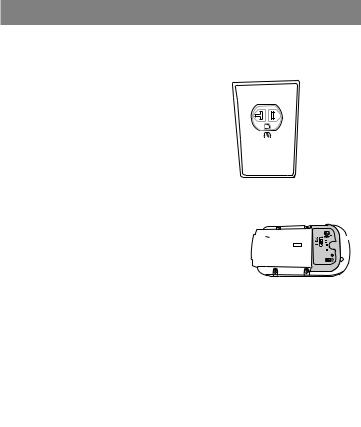
than one extension to make up the total length, be sure each extension contains at least the minimum wire size.
|
120V |
Minimum Gauge for Cord Sets |
|
|
|
||||
|
|
0-25 |
26-50 |
51-100 101-150 |
|
|
|||
|
Volts |
Total Length of Cord in Feet |
|
|
|
||||
|
240V |
|
0-50 |
51-100 101-200 201-300 |
|
|
|||
|
More Not more |
American Wire Gauge |
|
|
|
||||
|
Ampere Rating |
|
|
|
|
|
|||
|
Than Than |
|
|
|
|
|
|
||
|
0 |
- |
6 |
18 |
16 |
16 |
14 |
|
|
|
6 |
- |
10 |
18 |
16 |
14 |
12 |
|
|
|
10 |
- |
12 |
16 |
16 |
14 |
12 |
|
|
|
12 |
- |
16 |
14 |
12 |
Not Recommended |
|
|
|
|
|
|
|
|
|
|
|
|
|
9. Use only the supplied charger when charging your unit. The use |
|
||||||||
of any other charger could damage the battery pack or create a |
|
||||||||
hazardous condition. |
|
|
|
|
|
|
|||
10. Use only one charger when charging. |
|
|
|
||||||
11. Do not attempt to open the charger or the unit. There are no |
|
||||||||
customer serviceable parts inside. Return to any authorized |
|
||||||||
Black & Decker service center. |
|
|
|
|
|||||
12. DO NOT incinerate battery packs even if they are severely |
|
||||||||
damaged or completely worn out. |
|
|
|
|
|||||
13. Do not incinerate the batteries. They can explode in a fire. A |
|
||||||||
small leakage of liquid from the battery cells may occur under |
|
||||||||
extreme usage, charging or temperature conditions. This does |
|
||||||||
not indicate a failure. However, if the outer seal is broken and this |
|
||||||||
leakage gets on your skin: |
|
|
|
|
|||||
a. Wash quickly with soap and water. |
|
|
|
||||||
b. Neutralize with a mild acid such as lemon juice or |
|
||||||||
vinegar. |
|
|
|
|
|
|
|
||
c. If the battery liquid gets in your eyes, flush them with |
|
||||||||
clean water for a minimum of 10 minutes and seek |
|
||||||||
immediate medical attention. MEDICAL NOTE: The liquid |
|
||||||||
is a 25-35% solution of potassium hydroxide. |
|
||||||||
|
|
|
|
|
|
|
|
|
5 |
CHARGING PROCEDURE
THE BATTERY PACK IS NOT FULLYCHARGED AT THE FACTORY.CHARGE BATTERY PACK FOR AT LEAST 9 HOURS BEFORE USE.
The charger is designed to use standard |
|
household 120 volt 60 Hz power. |
|
1. Plug the charger into any standard 120 |
|
Volt 60 Hz electrical outlet (figu e 1). |
|
2. Slide the charger onto the battery pack |
|
as shown in figure 2 and let the battery |
|
pack charge initially for 9 hours. After |
|
the initial charge, under normal usage, |
|
your battery pack should be fully |
|
charged in 6 to 9 hours. |
|
2a) During charging the green LED will |
|
appear. |
|
2b) When charging is complete the green |
|
LED will go off. |
|
3. Unplug charger, and remove |
3 |
the battery pack. Place the |
|
battery pack into the tool until it “clicks” into place figure 3To. remove the battery pack,NOTE:press down on the release button on the back of the battery pack and slide out.
1



 2
2 
IMPORTANT CHARGING NOTES
1. After normal usage, your battery pack should be fully charged in 6 to 9 hours. If the battery pack is run-down completely, it may take up to 9 hours to become fully charged. Your battery pack was sent from the factory in an uncharged condition. Before attempting to use it, it must be charged for at least 9 hours.
2. DO NOT charge the battery pack in an air temperature below +40°F(+4.5°C), or above +105°F (+40.5°C). This is important and will prevent serious damage to the battery pack. Longest life and best performance can be obtained if battery pack is charged when air temperature is about 75°F (24°C).
3. While charging, the charger may hum and become warm to touch. This is a normal condition and does not indicate a problem.
4. If the battery pack does not charge properly—(1) Check current at receptacle by plugging in a lamp or other appliance. (2) Check to see if receptacle is connected to a light switch which turns power off when you turn out the lights. (3) Move charger and battery pack to a surrounding air temperature of 40°F (+4.5°C) to 105°F (+40.5°C). (4) If the receptacle and temperature are OK, and you do not get proper charging, take or send the battery pack and charger to your local Black & Decker service center. See Tools Electric in yellow pages.
5. The battery pack should be recharged when it fails to produce sufficient power on jobs which were easily done previously. DO NOT CONTINUE using unit with its battery pack in a depleted condition.
6. The battery pack will reach optimum performance after being cycled 5 times during normal usage. There is no need to run the battery pack down completely before recharging. Normal usage is the best method of discharging and recharging the battery pack.
STORAGE RECOMMENDATION
1.Store tool:
a.) with the battery pack removed and on the charger.
b.) ina placethat is coolanddryaway from directsunlightand excess heat or cold.
c.) out of the reach of children.
2. For prolonged storage such as over the winter,the battery pack should be fully charged and then removed from the charger.It should be charged again just prior to use.
LEAVING THE BATTERY PACK IN THE CHARGER
It is OK to leave battery packs on charge for long periods of time. The charger has a maintenance mode which gives the battery pack enough charge to stay “topped off”. If however, the tool is not expected to be needed for more than 30 days, unplug the charger and store battery pack in a cool, dry location. NOTE: A battery pack will lose its charge when kept off of the charger. If the battery pack has not been kept on maintenance charge, it may need to be recharged before use. A battery pack may also lose its charge if left in a charger that is not plugged into an appropriate AC source.
6
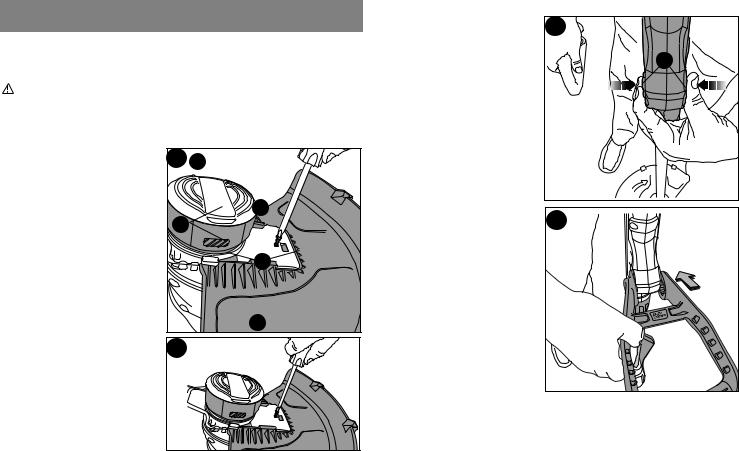
ASSEMBLY & ADJUSTMENT
ASSEMBLY TOOLS REQUIRED (NOT SUPPLIED):
- Phillips Screwdriver
INSTALLINGTHE GUARD
WARNING: REMOVE THE BATTERYFROM THE TOOL BEFORE ATTEMPTING TO ATTACH THE GUARD, EDGE GUIDE OR HANDLE. NEVER OPERATE TOOL WITHOUT GUARD FIRMLY IN PLACE. THE GUARDMUSTALWAYSBE ON THETOOL TO PROTECTTHE USER.
•Turn the trimmer upside down so that you are looking down at the spool cap (a).
•Turn the guard (b) upside down and slide it onto the motor housing (c). Make sure the tabs (d) on the guard engage the ribs (e) on the motor housing as shown.
•Continue to slide the guard on until you hear it “snap” into place.
•Using a phillips screwdriver, insert the guard screw as shown in figure 5 to complete the guard assembly.
•Once the guard is installed, remove the covering from the line cut-offblade, located on the edge of the guard
4 |
b |
|
c |
d |
|
|
e |
|
a |
5 |
|
ATTACHING THE AUXILIARY HANDLE |
|
• To attach the handle, press |
6 |
in on the buttons (f) on both |
|
sides of the upper housing |
f |
as shown in figure 6. |
|
• Position the handle as
shown in figure 7 (with the 7 Black & Decker logo facing upward). Partially push the handle on so that it will hold
the buttons in when you release them with your hand.
7
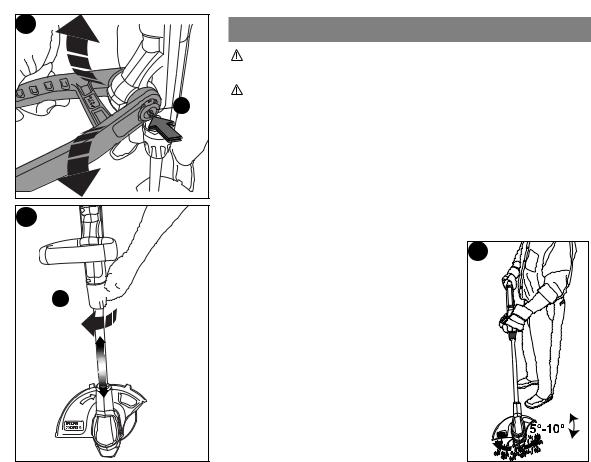
• Push the handle completely onto the housin and position it slightly until “snaps” into place (figure
• To adjust the handle up down, press in on the butt
(g) and raise or lower the handle.
• The handle should be adjusted so that your front arm is straight when the trimmer is in the working position.
HEIGHT ADJUSTMENT
• The overall height of the trimmer can be adjusted by loosening the collar (h) and rotating it in the direction of thearrow shown in figure9.
• Move the upper housing straight up or down. When the desired height is achieved, tighten the collar by rotating it opposite of the direction shown in figure 9.
8 |
g |
9 |
h 



OPERATING INSTRUCTIONS
WARNING: Always use proper eye protection that conforms to ANSI Z87.1 (CAN/CSA Z94.3) while operating this power tool.
CAUTION: Inspect area to be trimmed and remove any wire, cord, or string-like objects which could become entangled in the rotating line or spool. Be particularlycareful to avoid any wire which might be bent outwardly into the path of the tool, such as barbs at the base of a chain link fence.
SWITCHING ON AND OFF
• To switch the tool on, squeeze the trigger lever.
• To switch the tool off, release the trigger lever.
• With the unit on, angle unit and slowly swing the trimmer side to side as shown in figure 10.
10
8
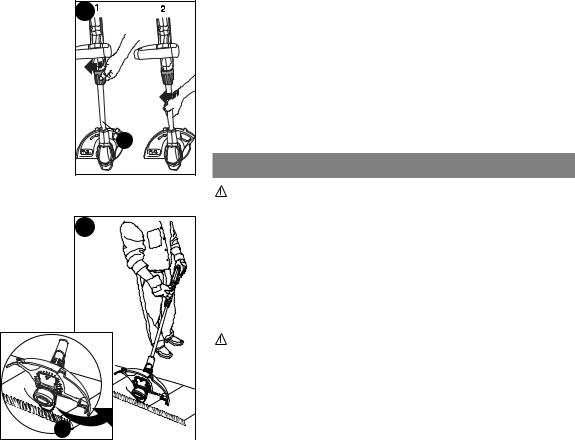
CONVERT TO EDGING MODE |
|
• To operate as a maintenance edger, turn |
11 |
the collar (h) as shown in part 1 of figure |
|
|
|
11. |
|
• Hold the metal shaft and rotate the lower |
|
housing 180° as shown in part 2. |
|
• Turn the collar (h) until tight. |
|
|
h |
• If desired, pull the wire edge guide (i) out |
12 |
from the motor housing until it clicks into |
|
the locked position as shown in figure 12 |
|
and position the trimmer above the surface |
|
as shown in figure 12. |
|
• Return to the trimming position by |
|
loosening the lock collar and rotating the |
|
lower housing back 180°. The tool will lock |
|
in the trimmer position. When using the |
|
tool, retract the wire edge |
|
guide to the original position, |
|
out of the way. |
|
CUTTING LINE / LINE FEEDING
Your trimmer uses .065 inch (1.65 mm) diameter, ROUND nylon line. During use, the tips of the nylon lines will become frayed and worn and the special self feeding spool will automatically feed and trim a fresh length of line. Cutting line will wear faster and require more feeding if the cutting or edging is done along sidewalks or other abrasive surfaces or heavier weeds are being cut. The advanced automatic line feeding mechanism senses when more cutting line is needed and feeds and trims the correct length of line whenever itʼs required. DO NOT BUMP unit on ground in attempt to feed line or for any other purposes.
REPLACEMENT ACCESSORIES
CAUTION: Before you begin trimming, only use the appropriate type of cutting line.
Use Black & Decker replacement spool Model No. AF-100. Reload nylon line (either bulk or prewound replacement spool) as shown in this manual.
• USE ONLY .065 inch (1.65 mm) DIAMETER ROUND NYLON MONOFILAMENT LINE. Do not use serrated or heavier gauge line, as they will overload the motor and cause overheating. This line is available at your local dealer or authorized service center.
• Other replacement parts (guards, spool caps, etc.) are available through Black & Decker service centers. To find your local service locationWARNING:call: 1-800-544-6986 or visit www.blackanddecker.com.
The use of any accessory not recommended by Black & Decker for use with this tool could be hazardous.
i 9
9
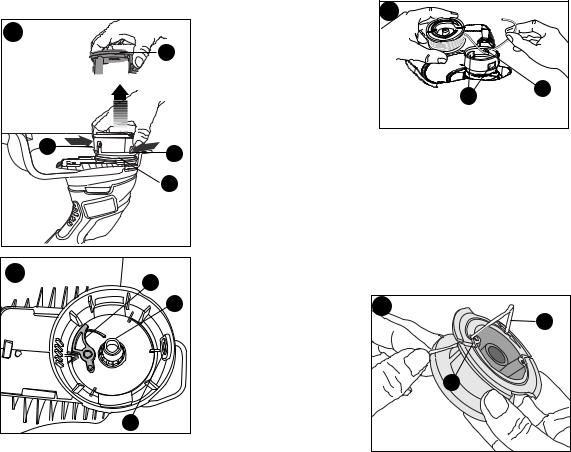
REPLACING THE SPOOL (FIGURES 13,14,15) |
|
|
• Remove battery from tool. |
13 |
|
• Depress the tabs (j) and |
|
|
remove the spool cap (k) |
Replacement |
k |
from the spool housing (l) in |
spool |
|
the trimmer head (figure 13). |
|
|
• For best results, replace |
Model # |
|
spool with Black & Decker |
|
|
model # AF-100. |
AF-100 |
|
• Grasp empty spool with one |
|
|
hand and spool housing with |
j |
|
other hand and pull spool out. |
j |
|
|
|
|
|
|
l |
• If lever (m) (figure 14) in |
|
|
base of housing becomes |
14 |
|
dislodged, replace in correct |
m |
|
position before inserting new |
|
|
spool into housing. |
|
o |
• Remove any dirt and grass |
|
|
from the spool and housing. |
|
|
• Unfasten the end of the |
|
|
cutting line and guide the line |
|
|
into the eyelet (n) figure 15. |
|
|
• Take the new spool and |
|
|
push it onto the boss (o) |
|
|
(figure 14) in the housing. |
|
|
Rotate the spool slightly until it |
|
n |
is seated. |
|
|
The line should protrude |
|
|
approximately 5-3/8 inches (136mm) from the housing. |
|
|
• Align the tabs on the spool |
15 |
|
cap with theslots(p)in the |
|
|
housing (figure 15). |
|
|
• Push the cap onto the |
|
|
housing until it snaps |
|
|
securely into place. |
|
|
CAUTION: To avoid tool |
p |
n |
damage, if the cutting line |
||
protrudes beyond the |
|
|
trimming blade, cut it off so |
|
|
that it just reaches the |
|
|
blade. |
|
|
REWINDING SPOOL FROM BULK LINE (USE ONLY .065 IN. |
|
ROUND DIAMETER LINE) (FIGURES 16,17,18) |
|
Bulk line is also available for purchase from your local retailer. |
|
NOTE: Hand wound spools from bulk line are likely to become |
|
tangled more frequently than Black & Decker factory wound |
|
spools. For best results, factory wound spools are |
|
recommended. |
|
To install bulk line, follow the steps below: |
|
• Remove battery from tool. |
|
• Remove the empty spool |
16 |
from the tool as described |
|
in “REPLACING THE |
q |
SPOOL”. |
|
• Remove any remaining |
|
cutting line from the spool. |
|
• Make a fold at the end of |
|
the cutting line at about 3/4 |
r |
inch (19mm)(q). Feed the |
|
cutting line into one of the |
|
line anchoring slots (r) as |
|
shown in figure 16. |
|
10
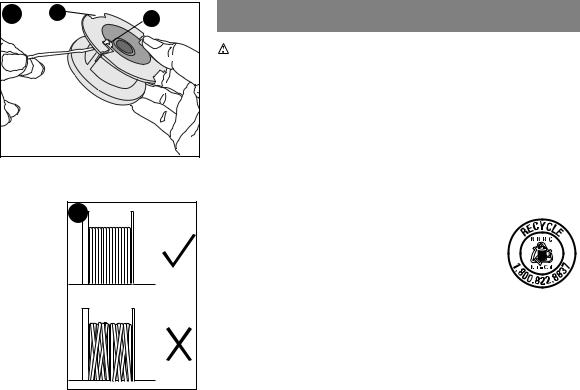
• Insert the 3/4 inch (19mm) |
t |
s |
|
end of the bulk line into the |
17 |
||
hole (s) in the spool |
|
|
|
adjacent to the slot as |
|
|
|
shown in figure 17. |
|
|
|
• Wind the cutting line onto the spool in |
18 |
the direction of the arrow on the spool. |
|
Make sure to wind the line on neatlyand |
|
in layers.Do not crisscross(figure 18). |
|
• When the wound cutting line reaches |
|
the recesses (t), cut the line. (figure 17). |
|
• Fit the spool onto the tool as described |
|
in “REPLACING THE SPOOL”. |
|
MAINTENANCE
WARNING: To avoid serious injury, remove the battery from the tool before performing any maintenance.
1. Keep the air intake slots clean to avoid overheating.
2. Your trimmer line can dry out over time. To keep your line in top condition, store spare pre-wound spools or bulk line in a plastic, sealable bag with a tablespoon of water.
3. Plastic parts may be cleaned by using a mild soap and a damp rag. 4. The line cutter on the edge of the guard can dull over time. It is recommended you periodically touch-up the sharpness of the
blade with a file.
IMPORTANT:To assure product SAFETY and RELIABILITY, repairs, maintenance and adjustment should be performed by authorized service centers or other qualified service organizations, always using identical replacement parts.
Battery Recycling and the RBRC™ Seal
The RBRC™ (Rechargeable Battery Recycling Corporation) Seal on the nickel-cadmium battery (or battery pack) indicates that the costs to recycle the battery (or battery pack) at the end of its useful life have already been paid by Black & Decker. In some
areas, it is illegal to place spent nickel-cadmium batteries in the trash or municipal solid waste stream and the RBRC program provides an environmentally conscious alternative.
RBRC in cooperation with Black & Decker and other battery users, has established programs in the United States and Canada to facilitate the collection of spent nickel-cadmium batteries. Help protect our environment and conserve natural resources by returning the spent nickel-cadmium battery to an authorized Black & Decker service center or to your local retailer for recycling. You may also contact your local recycling center for information on where to drop off the spent battery,or call 1-800-8-BATTERY.
11

TROUBLESHOOTING
TOOL RUNS SLOWLY
• Check that the spool housing can rotate freely. Carefully clean it if necessary.
• Check that the cutting line does not protrude more than approximately 5-3/8 inches (136mm) from the spool. If it does, cut it off so that it just reaches the line trimming blade.
AUTOMATIC LINE FEED DOES NOT WORK
• Keep the tabs depressed and remove the spool from the spool housing in the trimmer head.
• Pull the cutting line until it protrudes approximately 5-3/8 inches (136mm) from the spool. If insufficient cutting line is left on the spool, install a new spool of cutting line.
• Ensure that the line is not crisscrossed on the spool as detailed in figure 18. If it is, unwind the cutting line, then wind it back on the spool neatly so that the lines do not cross.
• Align the tabs on the spool cap with the cut outs in the housing.
• Push the spool onto the housing until it snaps securely into place.
• If the cutting line protrudes beyond the trimming blade, cut it off so that it just reaches the blade. If the automatic line feed still does not work or the spool is jammed, try the following suggestions:
• Carefully clean the spool and housing.
• Remove the spool and check if the lever in the spool housing can move freely.
• Remove the spool and unwind the cutting line, then wind it on neatly again. Replace the spool into the housing.
SERVICE INFORMATION
All Black & Decker Service Centers are staffed with trained personnel to provide customers with efficient and reliable power tool service. Whether you need technical advice, repair, or genuine factory replacement parts, contact the Black & Decker location nearest you. Tofind your local service location, refer to the yellow page directory under "Tools—Electric" or call: 1-800-544-6986 or visit www.blackanddecker.com
FULL TWO-YEAR HOME USE WARRANTY
Black & Decker (U.S.) Inc. warrants this product for two years against any defects in material or workmanship. The defective product will be replaced or repaired at no charge in either of two ways.
The first is to return the product to the retailer from whom it was purchased (provided that the store is a participating retailer). Returns should be made within the time period of the retailerʼs policy for exchanges (usually 30 to 90 days after the sale). Proof of purchase may be required. Please check with the retailer for their specific return policy regarding returns that are beyond the time set for exchanges.
The second option is to take or send the product (prepaid) to a Black & Decker owned or authorized Service Center for repair or replacement at our option. Proof of purchase may be required. Black & Decker owned and authorized Service Centers are listed under "Tools-Electric" in the yellow pages of the phone directory. This warranty does not apply to accessories. This warranty gives you specific legal rights and you may have other rights which vary from state to state or province to province. Should you have any questions, contact the manager of your nearest Black & Decker Service Center. This product is not intended for commercial use.
12

FREE WARNING LABEL REPLACEMENT: If your warning labels become illegible or are missing, call 1-800-544-6986 for a free replacement.
LATIN AMERICA: This warranty does not apply to products sold in Latin America. For products sold in Latin America, check country specific warranty information contained in the packaging, call the local company or see the website for warranty information.
Imported by |
See ʻTools-Electricʼ |
|
Black & Decker (U.S.) Inc., |
||
– Yellow Pages – |
||
701 E. Joppa Rd. |
||
for Service & Sales |
||
Towson, MD 21286 U.S.A. |
||
|
13
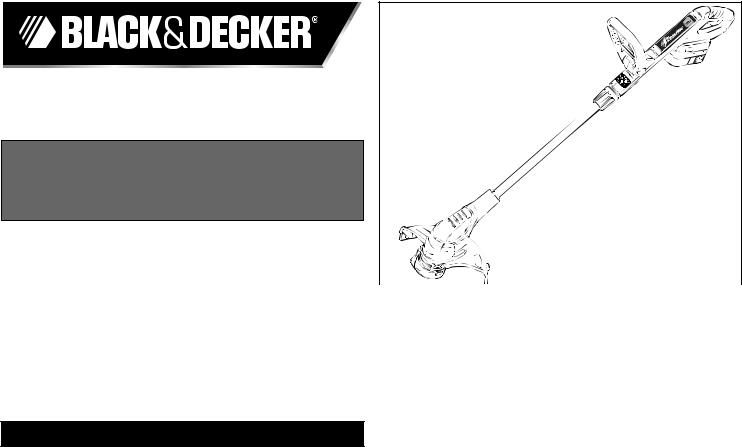
TAILLE-BORDURE / COUPEBORDUREMODED’EMPLOI
Numéros de modèle NST1118, NST2118
Consulter le site Web www.BlackandDecker.com/NewOwner pour enregistrer votre nouveau produit.
ALIRE AVANT DERETOURNER CE PRODUIT POUR QUELQUE RAISON QUE CE SOIT :
Si des questions ou des problèmes surgissentaprès lʼachat dʼun produit Black & Decker, consulter le site Web
HTTP://WWW.BLACKANDDECKER.COM/INSTANTANSWERS pour obtenir des réponses instantanément 24 heures par jour.
Si la réponse est introuvable ou en lʼabsence dʼaccès à lʼInternet, composer le 1 800 544-6986de 8 h à 17 h HNE, du lundi au vendredi, pour parler avec un agent.
Prière dʼavoir le numéro de catalogue sous la main lors de lʼappel.
CONSERVERCE MANUELPOURUN USAGEULTERIEUR.
Numéros de modèle
NST1118, NST2118
|
|
|
VOICI DES RENSEIGNEMENTS IMPORTANTS |
|
QUʼIL VOUS FAUT CONNAÎTRE : |
|
• Le pare-main doit être installé avant de débuter le taillage |
|
ou la coupe sinon le moteur surchauffera (page 21). |
|
• Utiliser seulement un fil ROND de 1,7 mm (0,065 po) de |
|
diamètre lors du remplacement (modèle AF-100 de B&D |
|
recommandé), sinon lʼappareil ne fonctionnera pas |
|
correctement (page 23). |
|
• Éviter de frapper la tête dʼalimentation contre le sol. En |
|
|
|
effet, cela endommagera le mécanisme dʼalimentation. |
14 |
|
